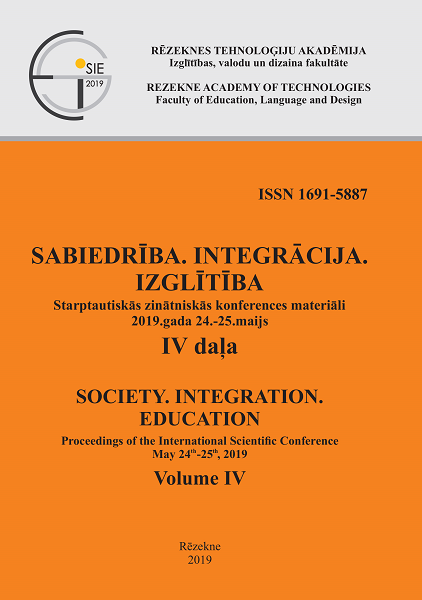ANALYSIS OF THE SELF-REPORTED PHYSICAL ACTIVITY QUESTIONNAIRES INDICATORS
DOI:
https://doi.org/10.17770/sie2019vol4.3746Keywords:
GPAQ, IPAQ, EHIS-PAQ concurrent validity, measurement properties, physical activityAbstract
“Global action plan on physical activity 2018–2030” emphasizes the need for weekly moderate physical activity for ensuring human health. Physical activity can be measured by a variety of objective and subjective methods, but one of the prerequisites for understanding the connection between active lifestyle and health certainty that the measuring instrument measures the feature for which it has been created and that it can be used in many countries. The goal of the research is to determine the correlations between measurement properties of fitness club clients’ self-reported physical activity indicators in the Global Physical Activity Questionnaire (GPAQ), International Physical Activity Questionnaire (IPAQ), European Health Interview Survey-Physical Activity Questionnaire (EHIS-PAQ), and to evaluate their concurrent validity. Methods: participants (volunteers) were 70 fitness club visitors (age 18-79). This research is preparative part for the further research of the project “European Physical Activity and Sports Monitoring System (EUPASMOS)”. The type, involvement and amount of physical activity was determined by the GPAQ, IPAQ and EHIS-PAQ adapted into Latvian. The research results showed that questionnaires allowed to determine the respondents’ physical activity indicators in and out of fitness club activities. Statistically significant correlations were determined between indicators obtained in all physical activity questionnaires applied in the research (p<0.05). This confirms that all three physical activity determination questionnaires can be used for physical activity research in Latvian environment.
Downloads
References
Baumeister, S., Ricci, C., Kohler, S., 1, Fischer, B., Töpfer, C., Finger, J., & Leitzmann, M. (2016). Physical activity surveillance in the European Union: reliability and validity of the European Health Interview Survey- Physical Activity Questionnaire (EHIS-PAQ) International Journal of Behavioral Nutrition and Physical Activity, 1-11, DOI 10.1186/s12966-016-0386-6
Bull, F.C., Maslin, T.S., Armstrong, T. (2009). Global Physical Activity Questionnaire (GPAQ): nine country reliability and validity study. Journal of physical activity & health, 6, 790–804. PMID: 20101923
Cardinal, B.J. (2016). Physical Activity Education's Contributions to Public Health and Interdisciplinary Studies: Documenting More than Individual Health Benefits, Journal of Physical Education, Recreation & Dance, 87, 4, 3-5. DOI: https://doi.org/10.1080/07303084.2016.1142182
Craig, C.L., Marshall, A.L., Sjostrom, M., Bauman, A.E., Booth, M.L., Ainsworth, B.E., Pratt, M., Ekelund, U., Yngve, A., Sallis, J.F., & Oja, P. (2003). International physical activity questionnaire: 12-country reliability and validity. Med Sci Sports Exerc., 35, 1381–95. DOI: 10.1249/01.MSS.0000078924.61453.FB.
Helmerhorst, H., Brage, S., Warren, J., Besson, H., & Ekelund, U. (2012). A systematic review of reliability and objective criterion-related validity of physical activity questionnaires. International Journal of Behavioral Nutrition and Physical Activity, 9, 103, DOI:10.1186/1479-5868-9-103
Kohl, H. 3rd , Craig C., Lambert, E. , Inoue, S, Alkandari, J.R., Leetongin, G., & Kahlmeier, S. (2012). The pandemic of physical inactivity: global action for public health. Lancet Physical Activity Series Working Group. Retrieved from https://www.ncbi.nlm.nih.gov/pubmed/22818941
Raask, T., Latt, E., Jurimae, J., Jurimae, T., Vainik, U., & Konstabel, K. (2017). Comparison of IPAQ-SF and Two Other Physical Activity Questionnaires with Accelerometer in Adolescent Boys. PLoS ONE, 12(1), e0169527. DOI:10.1371/journal.pone.0169527
Rivière, F., Widad, F. Z., Speyer, E., Erpelding, M. L., Escalon, H., & Vuillemin, A. (2016). Reliability and validity of the French version of the global physical activity questionnaire. Journal of sport and health science, 7(3), 339-345. DOI: 10.1016/j.jshs.2016.08.004
Van Poppel, M.N., Chinapaw, M.J., Mokkink, L.B. et al. (2010). Physical activity questionnaires for adults: a systematic review of measurement properties. Sports Medicine, 40(7), 565-600. DOI:10.2165/11531930-000000000-00000
Wanner, M., Hartman, C., Pestoni, G., Martin, B., Siegrist, M., & Martin-Diener, E. (2017). Validation of the global physical activity questionnaire for self-administration in a European context. BMJ Open Sport Exercise Medicine, 3(1), e000206.
WHO (2017). World Health organization. Retrieved from https://www.who.int/news-room/fact-sheets/detail/physical-activity


